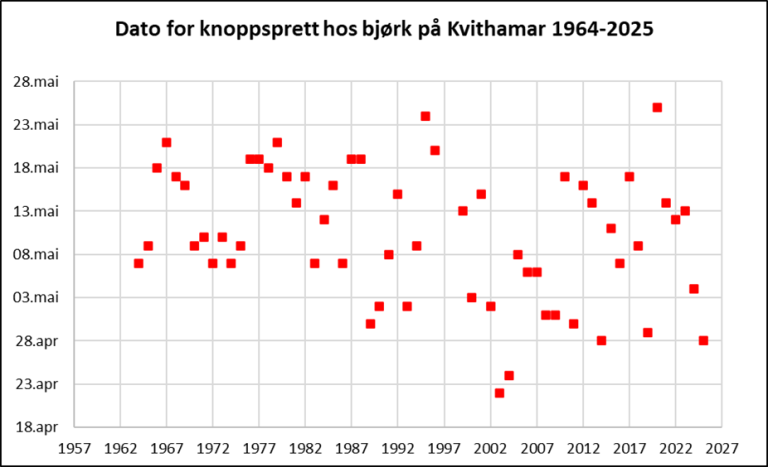
Tidsseriar for fenologiske observasjonar
Dei institusjonane som seinare har vorte NIBIO, har sidan 1963 vore med i eit europeisk nettverk av fenologiske hagar. Nettverket blir i dag koordinert frå Katholische Universität Eichstätt-Ingolstadt i Tyskland.
.jpg?quality=60)
Frå 1964 fram til i dag er det notert datoar for knoppsprett, blomstring, haustfarging og bladfall på ei rad treslag som er planta inn i desse hagane. Alle enkelttre av same art har felles opphav i eit mor-materiale som blir forvalta og oppformert i Bayern i Tyskland.
Dei hagane som NIBIO følgjer med på, ligg i Fana i Bergen og ved Kvithamar i Stjørdal. Data frå over 60 år med observasjonar gir grunnlag for å sjå korleis daglengde og temperatur styrer treslaga sine faseskifte frå vår til haust. Dei kan også gi indikasjonar på om lengda på vekstsesongen har endra seg som eit resultat av endringar i klima i same periode.
Artane i hagen ved Kvithamar er bjørk (Betula pubescens), gran (Picea abies, to økotypar), furu (Pinus sylvestris), bøk (Fagus sylvatica, to økotypar), osp (Populus tremula) lind (Tilia cordata), rogn (Sorbus aucuparia), søtkirsebær (Prunus avium, to økotypar), plommepil (Salix acutifolia), namdalspil (Salix smithiana), alperips (Ribes alpinum), europalerk (Larix decidua) og hassel (Corylus avellana).
Med utgangspunkt i observasjonane av bladsprett for bjørk, kunne ein seie at våren kom stadig tidlegare gjennom 40-årsperioden frå 1964 til 2005 (sjå artikkel under "Publikasjoner"). Data for bøk, lerk og osp viste ingen slik trend.
I åra etter 2005 har dato for bladsprett hos bjørk variert mykje mellom år, og ein har også hatt fleire seine vårar.

Publikasjoner
Forfattere
Øyvind Nordli Frans-Emil Wielgolaski Anne Kjersti Bakken Stein Harald Hjeltnes Finn Måge Anders Sivle Oddvar SkreSammendrag
Data series for bud burst, beginning of flowering and petal fall for 20 species of deciduous trees and conifers at four sites in different regions of southern Norway have been analysed and related to temperature series. On average, the spring phenophases occurred 7 days earlier during the period 1971–2005. The most significant linear trends were observed for the earliest phases. The trends in this period were compared with trends in other periods, the longest one starting in 1927. Those starting in cold decades and ending in 2005 were in most instances statistically significant, whereas hardly any significant trend appeared for series starting in warm decades. This fact showed that the results of trend studies are very sensitive to the choice of starting year. There were significant decadal variations in 40% of the series. The dates of occurrence of the phenophases, varying from the first days of May to the first days of June, correlated with seasonal temperature series, in most cases strongest to mean temperatures for the seasons March–May and April–May. The North Atlantic Oscillation Index (NAOI) for January and February appeared to have some predictive power for the date of occurrence of the recorded phases. The basis for this may be that the oscillations described by the index are of importance for the fulfilment of physiological chilling requirements needed to break bud dormancy. The same genotypes of the trees were grown in region West Norway and in Central Norwegian region; during the period 1965– 2005 the trends towards earlier bud burst were more pronounced and steeper at the western site.

.jpg)